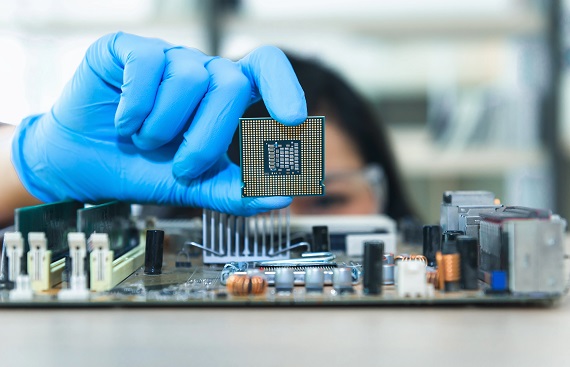Exploring the Untapped Potential of India's Semiconductor Industry

As India focuses on establishing its own semiconductor manufacturing ecosystem, there is growing optimism about the country's potential to become a major player in the chip design space. According to Rajan Anandan, Managing Director of Sequoia Capital, the country has the capability to excel in semiconductor design and recently invested in a deeptech startup, Mindgrove, that is focused on designing cost-effective and power-efficient system-on-chips (SoCs). While semiconductor manufacturing can be capital-intensive, Anandan believes that startups can play a crucial role in designing semiconductors and eventually establish fabs in India.
The focus on the domestic semiconductor industry in India has intensified following the acute shortage of the product globally after the first wave of Covid-19. This has impacted various industries, ranging from electronics to automobiles. Anandan notes that India is well-suited to play a bigger role in the global technology space with a boost to research and development and manufacturing sectors. With the largest number of software developers after the US, India has an extraordinary opportunity as concerns about purchasing Chinese technology continue to grow, and people look for alternatives.
As India continues to invest in the semiconductor industry, it is clear that the country has the potential to become a major player in the chip design space. The country's talent pool and rapidly growing ecosystem, combined with increased investment in research and development, provide a unique opportunity to shape the future of the semiconductor industry. The next 20-30 years are critical for India, and the country must capitalize on its strengths to ensure that it remains at the forefront of technological innovation.
Recent Developments in Semiconductor-Based Sensing and Detection
Semiconductor-based sensing and detection technology has rapidly evolved over the past decade, resulting in significant advances in fields such as healthcare, environmental monitoring, and security. These technologies rely on the unique electrical properties of semiconductors to detect and analyse a wide range of signals, from small changes in temperature to the presence of specific molecules in a sample. Applications of Semiconductor-Based Sensing and Detection: Semiconductor-based sensors have found extensive use in healthcare, environmental monitoring, and security. These sensors are able to detect biomolecules, pollutants, and hazardous chemicals with high accuracy, enabling early detection of diseases and real-time monitoring of environmental and security threats.
Recent developments in semiconductor-based sensing and detection technology have led to the development of sensors with even higher sensitivity and specificity, as well as new functionalities. For example, researchers have developed sensors that can detect changes in humidity and temperature simultaneously, allowing for more accurate monitoring of environmental conditions. They have also developed sensors that can detect multiple analyses in a single sample, which can significantly reduce the time and cost of analysis. In addition to these advances, researchers have also explored the potential of new semiconductor materials, such as graphene and nanowires, for sensing and detection applications.
The Ethical Issues in Semiconductor Research and Development
One of the main ethical issues in semiconductor research and development is the environmental impact of semiconductor manufacturing. The process of manufacturing semiconductors requires large amounts of energy and produces significant amounts of greenhouse gases, which can have negative impacts on the environment. Another ethical issue is the impact of semiconductor technology on society, particularly in terms of job displacement and income inequality. Additionally, there are concerns about the use of semiconductor technology for military and surveillance purposes, which can have significant ethical implications.
To address these ethical issues, the semiconductor industry has developed ethical codes and standards to ensure that the manufacturing process is as environmentally friendly as possible. Additionally, the industry has engaged with stakeholders to increase transparency and accountability, particularly in areas such as labour practices and supply chain management. There have also been efforts to incorporate ethical considerations into the research and development process itself, with researchers considering the potential social and environmental impacts of their work.
Semiconductor Devices: Semiconductors are a critical component in modern electronic devices. They are materials that have properties between those of insulators and conductors, which makes them useful for controlling the flow of electricity. Semiconductor devices, such as diodes and transistors, are used to build electronic circuits and systems that are essential in everyday life.
Diodes: A diode is a two-terminal device that allows current to flow in only one direction. It consists of a P-type semiconductor (which has excess holes) and an N-type semiconductor (which has excess electrons) that are joined together. When a voltage is applied across the diode in the forward direction, current flows easily through the junction. However, when the voltage is applied in the reverse direction, only a small leakage current flows. Diodes are commonly used in rectifier circuits to convert AC to DC and in voltage regulators to stabilize voltage.
Transistors: are three-terminal devices that are used to amplify or switch electronic signals. There are two main types of transistors: bipolar junction transistors (BJTs) and field-effect transistors (FETs). BJTs consist of three layers of semiconductor material, with two layers of one type sandwiching a layer of the other type. The base region is very thin, allowing for control of the flow of current through the device. FETs, on the other hand, consist of a semiconductor channel between two terminals. The flow of current in the channel is controlled by an electric field generated by the gate terminal. Transistors are used in a wide range of electronic devices, from computers to audio amplifiers.
Integrated Circuits: An integrated circuit (IC) is a complex circuit made up of many transistors, diodes, and other components on a single chip of semiconductor material. ICs are used in a wide range of electronic devices, including computers, mobile phones, and televisions. They are made using a process called photolithography, in which a pattern is etched onto a silicon wafer to create the desired circuit.
Light Emitting Diodes (LEDs): LEDs are semiconductor devices that emit light when a current is passed through them. They are commonly used in displays, indicator lights, and as a replacement for traditional light bulbs. LEDs are more energy-efficient than incandescent bulbs and have a longer life span.
Thyristors: Thyristors are four-layer, three-terminal semiconductor devices that are used in power control circuits. They can be used to control the flow of large amounts of current, making them useful in applications such as motor control and power supply regulation.
However, ethical issues such as environmental impact and societal implications must be considered. The semiconductor industry has taken steps to address these concerns, including the development of ethical codes and standards and engaging with stakeholders.
Read More News :
Sonata Software Achieves the Status of Microsoft Cloud Solution Partner
InfoVision - IIT Hyderabad collaborate to foster synergy between industry & academia

.jpg)

.jpg)